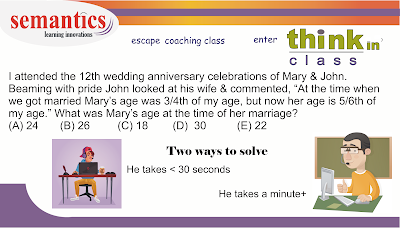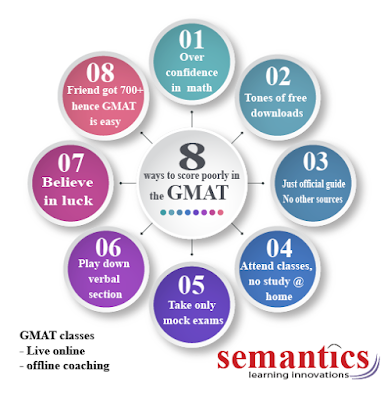The directions:
(some tips below may require you to revisit these directions)
This problem consists of a question and two statements, labeled (1) and (2), in which certain data are given. You have to decide whether the data given in the statements are sufficient for answering the question. Using the data given in the statements plus your knowledge of mathematics and everyday facts (such as the number of days in July or the meaning of counterclockwise), you must indicate whether:
A statement (1) ALONE is sufficient, but statement (2) alone is not sufficient to answer the question asked;
B statement (2) ALONE is sufficient, but statement (1) alone is not sufficient to answer the question asked;
C BOTH statements (1) and (2) TOGETHER are sufficient to answer the question asked, but NEITHER statement ALONE is sufficient;
D EACH statement ALONE is sufficient to answer the question asked;
E statements (1) and (2) TOGETHER are NOT sufficient to answer the question asked, and additional data specific to the problem are needed.
To understand the directions better,watch this video
Now here are some simple not do's
1. Assume that a given number is positive only
The numbers can be zero, negative fractions or decimals.Sample question
Is the modulus of X less than 3?
(1) X(X+3) is lesser than 0
(2) X(X-3) is greater than 0 When you substitute values for x, some of you usually use positive integers. you must also substitute other types of numbers like zero, negative, fraction or decimal...
2. Assume that in a ‘Is...( refer main statement in point 1 above ) question type, no is an invalid answer.
‘yes,’ can be a valid answer; no can be a valid answer.
You can mark A or B or C or D.
‘sometimes yes and sometimes no’ are invalid.
You should mark E.You can mark A or B or C or D.
‘sometimes yes and sometimes no’ are invalid.
3. Ignore minimum factors required (that can be gauged from the main statement) to answer the question,
if either of the sub statements do not have the minimum factors, the answers cannot be A or B.
for example
Is X greater than Y?for example
(1) X is greater than Z
(2) Y is lower than Z
We need information on X,Y to compare
Here as per directions, the answer cannot be A or B.
4. Conclude based on the outcome, while substituting a positive number to arrive at the answer.
Check the outcome while substituting varied numbers i.e. zero,+ve integer,-ve integer,+ve fraction and –ve fraction
5. Hurriedly mark either A (or B) as the answer option when statement 1(or 2) yields an answer.
Study statement 2(or 1)also . If this also leads to answer mark D, else mark A(or B)6. Spend time deriving absolute values when approximation is sufficient in arriving at a decision.
You can save time by arriving at a range of possible answers than by arriving at an absolute answer
Use approximation
7. Arriving at numerical values when the question requires only counting the occurrences.
Most test takers focus on solving the equation when they see an equation.
For example:
How many values can satisfy the equation x^2 +3x +5=0 ?
You should know that x^2 +3x + 5=0 will have two values for x (as the power of x is 2) You need not spend time solving this equation.
8. Attempt a complex combinatorics problem by attempting to pick/select many objects at a time. pick/select one object at a time. This doesn’t change the final outcome.
In probability, test takers find it difficult to approach a question
For example.
what is probability of picking 3 red balls out of 10 balls in from a bag ?
You can either pick 3 balls in one go
or
you can pick one ball at a time
Either way the answer remains same.
If you focus on picking one item at a time, you will be able to arrive at a solution easily.
9. Follow faulty logic.
i.e. A sample sum
main statement: Is the modulus of X less than 3?
sub statements:
(1) X(X+3) greater than 0
(2) X(X-3) lesser than 0
While substituting number to check the inequality always use the correct logic
Correct logic
Determine the range of numbers which satisfy the sub statements
Check whether these numbers satisfy the main statement.
Wrong logic
Determine the range of numbers which satisfy the main statement
Check whether these numbers satisfy the sub statements.
main statement: Is the modulus of X less than 3?
sub statements:
(1) X(X+3) greater than 0
(2) X(X-3) lesser than 0
While substituting number to check the inequality always use the correct logic
Correct logic
Determine the range of numbers which satisfy the sub statements
Check whether these numbers satisfy the main statement.
Wrong logic
Determine the range of numbers which satisfy the main statement
Check whether these numbers satisfy the sub statements.
10. Ignoring additional information required to solve the problem
Sample problemA and B takes x and y days respectively to complete a work. How many days will A and B together take to complete it?
(1) x=5
(2) B alone takes twice as many days as A alone to complete the work
additional information on the efficiency of each person’s work per day is a factor needed. If A works at 50% efficiency, A will take 10 days to complete the work.

















